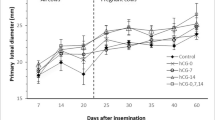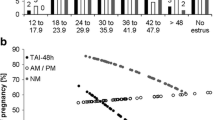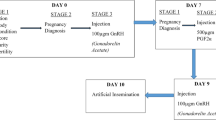Abstract
The objective of this study was to determine the effect of timing of artificial insemination on pregnancy rates, calving rates, abortion rates, twinning rates, and calf gender ratio after synchronization of ovulation with Ovsynch protocol in Holstein dairy cows. The ovulation of 219 lactating Holstein dairy cows was synchronized using the Ovsynch protocol. Therefore, cows received an injection of GnRH followed by an injection of prostaglandin F2α 7 days later and a second treatment with GnRH 2 days later. Cows were artificially inseminated at 0, 12, or 24 h after the second injection of GnRH. Reproductive performance did not differ between cows inseminated at 0 h (n = 82), 12 h (n = 66), or 24 h (n = 71) after the last injection of GnRH (pregnancy rate: 0 h 48 %, 12 h 47 %, 24 h 52 %; abortion rate: 0 h 5 %, 12 h 0 %, 24 h 11 %; calving rate: 0 h 43 %, 12 h 47 %, 24 h 41 %; twinning rate: 0 h 2 %, 12 h 0 %, 24 h 0 %; calf gender ratio (F/M): 0 h 61:39 %, 12 h 48:52 %, 24 h 39:61 %; P > 0.05). Pregnancy rates for cows inseminated in postpartum times of 50–75, 76–100, and >100 days within the first and ≥3 parities were statistically similar (P > 0.05), but pregnancy rates for cows inseminated at different postpartum times of 50–75, 76–100, and >100 days within the second parity were different (P < 0.01). In general, pregnancy rates of cows inseminated at different postpartum times (P < 0.01) and parities (P < 0.001) differed. The findings of the current study showed that rates of pregnancy, abortion, calving, and twinning of Holstein dairy cows subjected to artificial insemination at different times after synchronization were similar. These results also indicate that the timing of artificial insemination after synchronization did not influence calf gender ratio. Furthermore, pregnancy rates of Holstein dairy cows inseminated after synchronization were significantly influenced by postpartum time and parity number.
Similar content being viewed by others
References
Butler, W.R., 2000. Nutritional interactions with reproductive performance in dairy cattle. Animal Reproduction Science, 60–61, 449–457.
Cartmill, J.A., El-Zarkouny, S.Z., Hensley, B.A., Lamb, G.C. and Stevenson, J.S., 2001. Stage of cycle, incidence and timing of ovulation and pregnancy rate in dairy cattle after three timed breeding protocols. Journal of Dairy Science, 84, 1051–1059.
Clutton-Brock, T.H. and Iason, G.R. 1986. Sex ratio variation in mammals. Quarterly Review of Biology, 61, 339–374.
DeJarnette, J.M., Salverson, R.R. and Marshall, C.E., 2001. Incidence of premature estrus in lactating dairy cows and conception rates to standing estrus or fixed-time inseminations after synchronization using GnRH and PGF2α. Animal Reproduction Science, 67, 27–35.
Demiral, O., Un, M., Abay, M. and Bekyurek, T., 2007. The effect of artificial insemination timing on the sex ratio of offspring and fertility in dairy cows. Turkish Journal of Veterinary and Animal Sciences, 31(1), 21–24.
Dogruer, G., Saribay, M.K., Karaca, F. and Ergun, Y., 2010. The comparison of the pregnancy rates obtained after the ovsynch and double dose PGF2α + GnRH applications in lactating dairy cows. Journal of Animal and Veterinary Advances, 9 (4), 809–813.
Dorsey, B.R., Kasimanickam, R., Whittier, W.D., Nebel, R.L., Wahlberg, M.L. and Hall, J.B., 2011. Effect of time from estrus to AI on pregnancy rates in estrous synchronized beef heifers. Animal Reproduction Science, 127, 1–6.
Eddy, R.G., Davies, O. and David, C., 1991. An economic assessment of twin births in British dairy herds. Veterinary Record, 129, 526–529.
Ericsson, R.J. and Ericsson, S.A., 1998. Sex ratios. In: E. Knobil and J.D. Neill (eds), Encyclopedia of Reproduction. Volume 4, Academic Press, San Diego, CA, 431–437.
Garcia-Ispierto, I., López-Gatius, F., Bech- Sábat, G., Yániz, J.L., Angulo, E., Maris, C., Floc’h S. and Martino, A., 2010. Effects of a progesterone-based oestrus synchronization protocol in 51-to-57-day postpartum high-producing dairy cows. Reproduction in Domestic Animals, 45, 168–173.
Kasimanickam, R., Hall, J.B., Currin, J.F., Inman, B., Rudolph, J.S. and Whittier, W.D., 2010. Pregnancy rates in angus cross beef cows bred at observed oestrus with or without second gnrh administration in fixed-time progesterone-supplemented ovsynch and co-synch protocols. Reproduction in Domestic Animals, 45, 487–492.
Kinsel, M.L., Marsh, W.E., Ruegg, P.L. and Etherington,W.G., 1998. Risk factors for twinning in dairy cows. Journal of Dairy Science, 81, 989–993.
López-Gatius, F., Santolaria, P., Yániz, J.L., Garbayo, J.M. and Hunter, R.H.F., 2004. Timing of early foetal loss for single and twin pregnancies in dairy cattle. Reproduction in Domestic Animals, 39, 429–433.
Lucy, M.C., 2001. Reproductive loss in high-producing dairy cattle: where will it end? Journal of Dairy Science, 84, 1277–1293.
Martinez, F., Kaabi, M., Martinez-Pastor, F., Alvarez, M., Anel, E., Boixo, J.C., de Paz, P. and Anel, L., 2004. Effect of the interval between estrus onset and artificial insemination on sex ratio and fertility in cattle: a field study. Theriogenology, 62, 1264–1270.
Moreira, F., de La Sota, R.L., Diaz, T. and Thatcher, W.W., 2000. Effect of day of the estrous cycle at the initiation of a timed artificial insemination protocol on reproductive responses in dairy heifers. Journal of Animal Science, 78, 1568–1576.
Nielen, M., Schukken, Y.H., Scholl, D.T., Wilbrink, H.J. and Brand, A., 1989. Twinning in dairy cattle: a study of risk factors and effects. Theriogenology, 32, 845–862.
Pursley, J.R., Kosorok, M.R. and Wiltbank, M.C., 1997a. Reproductive management of lactating dairy cows using synchronization of ovulation. Journal of Dairy Science, 80, 301–306.
Pursley, J.R., Wiltbank, M.C., Stevenson, J.S., Ottobre, J.S., Garverick, H.A. and Anderson, L.L., 1997b. Pregnancy rates per artificial insemination for cows and heifers inseminated at a synchronized ovulation or synchronized estrus. Journal of Dairy Science, 80, 295–300.
Pursley, J.R., Silcox, R.W. and Wiltbank, M.C., 1998. Effect of time of artificial insemination on pregnancy rates,calving rates, abortion rates, and gender ratio after synchronization of ovulation in lactating dairy cows. Journal of Dairy Science, 81, 2139–2144.
Rabiee, A.R., Lean, I.J. and Stevenson, M.A., 2005. Efficacy of ovsynch program on reproductive performance in dairy cattle: A meta-analysis. Journal of Dairy Science, 88, 2754–2770.
Rorie, R.W., 1999. Effect of timing of artificial insemination on sex ratio. Theriogenology, 52, 1273–1280.
Rorie, R.W., Lester, T.D., Lindsey, B.R. and McNew, R.W., 1999. Effect of timing of artificial insemination on gender ratio in beef cattle. Theriogenology, 52, 1035–1041.
Santos, J.E.P., Thatcher, W.W., Chebel, R.C., Cerri, R.L.A. and Galvao, K.N., 2004. The effect of embryonic death rates in cattle on the efficacy of estrus synchronization programs. Animal Reproduction Science, 83, 513–535.
SAS., 1995. Statistical analysis system SAS/STATE user guide. Version 6.12, SAS Institute Inc. Cary, NC, USA.
Smith, M.W. and Stevenson, J.S., 1995. Fate of the dominant follicle, embryonal survival, and pregnancy rates in dairy cattle treated with prostaglandin F2a and progestins in the absence or presence of a functional corpus luteum. Journal of Animal Science, 73, 3743–3751.
Tenhagen, B.A., Drilhch, M., Surholt, R. and Heuwieser, W. 2004. Comparison of timed AI after synchronized ovulation to AI at estrus: Reproductive and economic considerations. Journal of Dairy Science, 87, 85–94.
Thatcher, W.W., Mattos, R., Moreira, F., Binelli, M. and Ambrose, J. D., 2000. Experimental manipulation of follicular growth. Reproduction in Domestic Animals, Suppl. 6, 27–33.
Thurmond, M.C. and Picanso, J.P., 1993. Fetal loss associated with palpation per rectum to diagnose pregnancy in cows. Journal of the American Veterinary Medical Association, 203, 432–435.
Thurmond, M.C., Picanso, J.P. and Jameson, C.M., 1990. Considerations for use of descriptive epidemiology to investigate fetal loss in dairy cows. Journal of the American Veterinary Medical Association, 197, 1305–1312.
Wehner, G.R., Wood, C., Tague, A., Barker, D. and Hubert, H., 1997. Efficiency of the Ovatec unit for estrus detection and calf sex control in beef cows. Animal Reproduction Science, 46, 27–34.
Williams, S.W., Stanko, R.L., Amstalden, M. and Williams, G.L., 2002. Comparison of three approaches for synchronization of ovulation for timed artificial insemination in Bos indicus-influenced cattle managed on the Texas gulf coast. Journal of Animal Science, 80, 1173–1178.
Acknowledgments
The authors thank the financial and in-kind support of DIMES. The authors thank Mr. Ali Riza Diren, Mr. Koray Suner, and their staff for the technical support.
Author information
Authors and Affiliations
Corresponding author
Rights and permissions
About this article
Cite this article
Bayril, T., Yilmaz, O. Effect of timing of artificial insemination after synchronization of ovulation on reproductive performance in Holstein dairy cows. Trop Anim Health Prod 45, 411–416 (2013). https://doi.org/10.1007/s11250-012-0231-0
Accepted:
Published:
Issue Date:
DOI: https://doi.org/10.1007/s11250-012-0231-0




